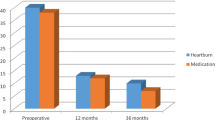Abstract
Background
Hiatal hernia, present radiologically in about 50% of patients desiring bariatric surgery, has been thought a contraindication to laparoscopic adjustable gastric banding (LAGB). Posited was the notion that adding crural repair to LAGB would enable this procedure to be offered to patients desiring bariatric surgery who had hiatal hernias.
Methods
After obtaining IRB approval, charts of all patients who underwent simultaneous crural repair and LAGB from June 2003 to January 2006 were reviewed. All patients were evaluated with the DeMeester score and the GERD-HQRL score pre- and postoperatively. Statistical analyses included the Mann–Whitney U test and the Chi-squared test.
Results
Twenty-one patients underwent laparoscopic procedure with crural repair; none required conversion to an open procedure. There were no mortalities. Two complications, a wound infection at the level of the port, and a case postoperative dysphagia resolved with therapy. Eighty-six percent of the patients ceased regular intake of heartburn medicines, P < .01. Median percent excess weight loss was 45% at 1 year and 55% at 2 years. The modified DeMeester score fell to 0–2 postoperatively (P < .01). Two years after the procedure, symptoms were less, as assessed by GERD-HQRL scores (P < .01).
Conclusion
Crural repair permits LAGB to be safely and effectively performed in patients with hiatal hernia.

Similar content being viewed by others
References
Ovrebo KK, Hatlebakk JG, Viste A, et al. Gastroesophageal reflux in morbidly obese patients treated with gastric banding or vertical banded gastroplasty. Ann Surg. 1998;228:51–8.
Wilson LJ, Ma W, Hirschowitz BI. Association of obesity with hiatal hernia and esophagitis. Am J Gastroenterol. 1999;94:2840–4.
Frigg A, Peterli R, Zynamon A, et al. Radiological and endoscopic evaluation for laparoscopic adjustable gastric banding: preoperative and follow up. Obes Surg. 2001;11:594–9.
Forsell P, Hallerback B, Glise H, et al. Complications’ following Swedish adjustable gastric banding: a long-term follow up. Obes Surg. 1999;9:11–6.
Zacharoulis D, Chadhury R, Dobbins B, et al. Laparoscopic adjustable silicone gastric banding: surgical and radiological approach. Obes Surg. 2002;12:280–4.
Angrisani L, Iovino P, Lorenzo M, et al. Treatment of morbid obesity and gastroesophageal reflux with hiatal hernia by Lap-Band. Obes Surg. 1999;9:396–8.
Dixon JB, O’Brien PE. Gastroesophageal reflux in obesity: the effect of lap-band placement. Obes Surg. 1999;9:527–31.
Iovino P, Angrisani L, Tremolaterra F, et al. Abnormal esophageal acid exposure is common in morbidly obese patients and improves after successful Lapband system implantation. Surg Endosc. 2002;16:1631–5.
Greenstein RJ, Nissan A, Jaffin B. Esophageal anatomy and function in laparoscopic gastric restrictive bariatric surgery: implications for patient selection. Obes Surg. 1998;8:199–206.
Dolan K, Finch R, Fielding G. Laparoscopic gastric banding and crural repair in the obese patient with a hiatal hernia. Obes Surg. 2003;13:772–5.
Fielding G, Rhodes M, Nathanson LK. Laparoscopic gastric banding for morbid obesity. Surgical outcome in 335 cases. Surg Endosc. 1999;13:550–4.
Frezza EE. Slim the Italian way. 2nd ed. Cine-Med publishing; November 2006. ISBN#978-0-9749358-8-1.
Frezza EE, Shebani KO, Wachtel MS. Morbid obesity causes increased intraabdominal pressure. Dig Dis Sci. 2007;52(4):1038–41.
Naslund E, Granstrom L, Melcher A, et al. Gastrooesophageal reflux before and after vertical banded gastroplasty in the treatment of obesity. Eur J Surg. 1996;162:303–6.
Lundell L, Ruth M, Olbe L. Vertical banded gastroplasty or gastric banding for morbid obesity: effects on gastroesophageal reflux. Eur J Surg. 1997;163:525–31.
Kiewiet RM, van Vilet ACM. Gastro-esophageal reflux in morbidly obese patients is associated with hiatal hernias but not with body mass index. J Med. (Letter to the Editor) 2006;64(8):315.
Ramalingam G, et al. Laparoscopic adjustable gastric banding in a patient with an incidental para-hiatal hernia. Obes Surg. 2006;16(1):98–101.
Weiss HG, Nehoda H, Labeck B, et al. Treatment of morbid obesity with laparoscopic adjustable gastric banding affects esophageal motility. Am J Surg. 2000;180:479–82.
Frezza EE, Ikramuddin S, Gourash W, et al. Symptomatic improvement in gastroesophageal reflux disease (GERD) following Roux-en-Y gastric bypass. Surg Endosc. 2002;16:1027–31.
Smith SC, Edwards CB, Goodman GN. Symptomatic and clinical improvement in morbidly obese patients with gastroesophageal reflux disease following Rouxen-Y gastric bypass. Obes Surg. 1997;7:479–84.
Jones KB Jr. Roux-en-Y gastric bypass: an effective antireflux procedure in the less than morbidly obese. Obes Surg. 1998;8:35–8.
Smith CD, Herkes SB, Behrm KE, et al. Gastric acid secretion and vitamin B12 absorption after vertical Roux-en-Y gastric bypass for morbid obesity. Ann Surg. 1993;218:91–6.
O’Brien PE, Brown WA, Smith A, et al. Prospective study of a laparoscopically placed adjustable gastric band in the treatment of morbid obesity. Br J Surg. 1999;85:113–8.
Angrisani L, Alkilani M, Basso N, et al. Laparoscopic Italian experienced with the Lap-Barid. Obes Surg. 2001;4(1):307–10.
Szold A, Abu-Abeid S. Laparoscopic adjustable silicone gastric-banding for morbid obesity. Surg Endosc. 2002;16:230–3.
deJong R, van Romshorst B, Timmer R, Gooszen HG, Smout AJ. The influence of laparoscopic adjustable gastric banding on gastroesophageal reflux. Obes Surg. 2004;14(3):399–406.
Author information
Authors and Affiliations
Corresponding author
Rights and permissions
About this article
Cite this article
Frezza, E.E., Barton, A. & Wachtel, M.S. Crural Repair Permits Morbidly Obese Patients with Not Large Hiatal Hernia to Choose Laparoscopic Adjustable Banding as a Bariatric Surgical Treatment. OBES SURG 18, 583–588 (2008). https://doi.org/10.1007/s11695-007-9339-0
Received:
Accepted:
Published:
Issue Date:
DOI: https://doi.org/10.1007/s11695-007-9339-0




